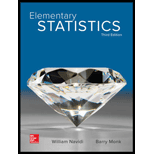
What do the numbers mean? A survey is administered by a marketing firm. Two of the people surveyed are Brenda and Jason. Three of the questions are as follows:
- Do you favor the construction of a new shopping mall?
- How many cars do you own?
- What is your marital slams?
(1) Strongly oppose (2) Somewhat oppose (3) Neutral (4) Somewhat favor (5) Strongly favor
(1) Married (2) Single (3) Divorced (4) Domestically partnered (5) Other
- Are the responses for question (i) nominal or ordinal?
- On question (i), Brenda answers (2) and Jason answers (4). Jason’s answer (4) is greater than Brenda’s answer (2). Does Jason’s answer reflect more of something?
- Jason’s answer to question (i) is twice as large as Brenda’s answer. Does Jason’s answer reflect twice as much of something? Explain.
- Are the responses for question (ii) qualitative or quantitative?
- On question (ii). Brenda answers 2 and Jason answers 1. Does Brenda’s answer reflect more of something? Does Brenda’s answer reflect twice as much of something? Explain.
- Are the responses for question (iii) nominal or ordinal?
- On question (iii). Brenda answers (4) and Jason answers (2). Does Brenda’s answer reflect more of something? Does Brenda’s answer reflect twice as much of something? Explain.
a.
To identify:whether the responses for question (i) nominal or ordinal.
Answer to Problem 49E
The responses for question (i): ordinal.
Explanation of Solution
Given information:A survey is administered by a marketing firm. Two of the people surveyed are Brenda and Jason. Three of the questions are as follows:
Do you favor the construction of a new shopping mall?
(1) Strongly oppose (2) Somewhat oppose (3) Neutral (4) Somewhat favor (5) Strongly favor
ii. How many cars do you own?
iii. What is your marital status?
(1) Married (2) Single (3) Divorced (4) Domestically partnered (5) Other
Concept Involved:
There are various methods of collecting information by sampling. Once the information has been collected, the collection is called a data set. Variables can be divided into two types: qualitative and quantitative. Qualitative variables are also called categorical variable, classify individuals into categories. Quantitative variables are numerical and tell how much of something there is.
Qualitative variables come in two types: ordinal variables and nominal variables.
Ordinal variables are qualitative variables whose categories have a natural ordering.
Nominal variables are qualitative variables whose categories have no natural ordering.
Quantitative variables can be either discrete or continuous.
Discrete variables are those whose possible values can be listed. Often, discrete variables result from counting something, so the possible values of the variable are 0, 1, 2 and so forth.
Continuous variables can, in principle, take on any value within some interval.
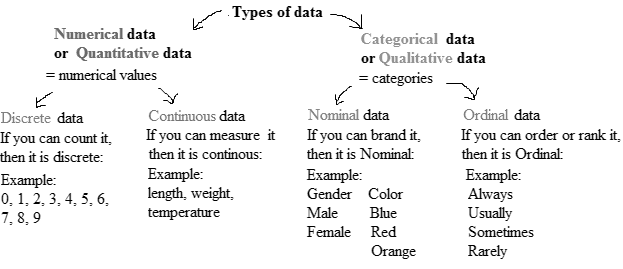
The values are classified into categories in a nominal variable, but no natural ordering is there in categories, whereas, the values are also classified into categories in an ordinary variablebut a natural ordering is there in categories.
Thus, to given question the choices for response has natural ordering with strongly oppose which indicating negative opinion and favor stating intensely positive feedback is ordinal variable.
Therefore, responses to given question are ordinal.
b.
To identify:Whether Jason’s answer reflects more of something.
Answer to Problem 49E
Jason’s answer reflects that he is favor of constructing a new shopping mall unlike Brenda
Explanation of Solution
Given information: A survey is administered by a marketing firm. Two of the people surveyed are Brenda and Jason. Three of the questions are as follows:
i. Do you favor the construction of a new shopping mall?
(1) Strongly oppose (2) Somewhat oppose (3) Neutral (4) Somewhat favor (5) Strongly favor
ii. How many cars do you own?
iii. What is your marital status?
(1) Married (2) Single (3) Divorced (4) Domestically partnered (5) Other
On question (i), Brenda answers (2) and Jason answers (4). Jason’s answer (4) is greater than Brenda’s answer (2).
Concept Involved:
There are various methods of collecting information by sampling. Once the information has been collected, the collection is called a data set. Variables can be divided into two types: qualitative and quantitative. Qualitative variables are also called categorical variable, classify individuals into categories. Quantitative variables are numerical and tell how much of something there is.
Qualitative variables come in two types: ordinal variables and nominal variables.
Ordinal variables are qualitative variables whose categories have a natural ordering.
Nominal variables are qualitative variables whose categories have no natural ordering.
Quantitative variables can be either discrete or continuous.
Discrete variables are those whose possible values can be listed. Often, discrete variables result from counting something, so the possible values of the variable are 0, 1, 2 and so forth.
Continuous variables can, in principle, take on any value within some interval.

It is given that Brenda answered 2 and Jason answered 4. Thus Jason’s answer reflect more of positivity, as he though not sure of intensity of favoring the construction supported it, unlike Brenda.
c.
To identify:Whether Jason’s answer reflects twice as much of something.
Answer to Problem 49E
The variable response to given question is categorical in nature, so it doesn’t not imply Jason’s answer to given question is twice as much of something
Explanation of Solution
Given information: A survey is administered by a marketing firm. Two of the people surveyed are Brenda and Jason. Three of the questions are as follows:
i. Do you favor the construction of a new shopping mall?
(1) Strongly oppose (2) Somewhat oppose (3) Neutral (4) Somewhat favor (5) Strongly favor
ii. How many cars do you own?
iii. What is your marital status?
(1) Married (2) Single (3) Divorced (4) Domestically partnered (5) Other
Jason’s answer to question (i) is twice as large as Brenda’s answer.
Concept Involved:
There are various methods of collecting information by sampling. Once the information has been collected, the collection is called a data set. Variables can be divided into two types: qualitative and quantitative. Qualitative variables are also called categorical variable, classify individuals into categories. Quantitative variables are numerical and tell how much of something there is.
Qualitative variables come in two types: ordinal variables and nominal variables.
Ordinal variables are qualitative variables whose categories have a natural ordering.
Nominal variables are qualitative variables whose categories have no natural ordering.
Quantitative variables can be either discrete or continuous.
Discrete variables are those whose possible values can be listed. Often, discrete variables result from counting something, so the possible values of the variable are 0, 1, 2 and so forth.
Continuous variables can, in principle, take on any value within some interval.
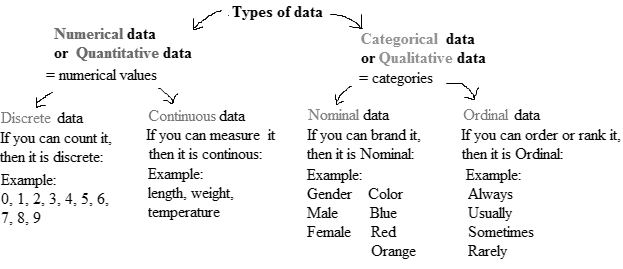
It is given that Brenda answered 2 and Jason answered 4. Thus Jason’s answer reflect more of positivity, as he though not sure of intensity of favoring the construction supported it, unlike Brenda. It is given Jason’s answer to given question is twice as large as Brenda, which does not implies twice as much of something, because, the variable response to given question is categorical in nature.
d.
To identify:Whether question (ii) qualitative or quantitative.
Answer to Problem 49E
The responses for question (ii): quantitative
Explanation of Solution
Given information: A survey is administered by a marketing firm. Two of the people surveyed are Brenda and Jason. Three of the questions are as follows:
i. Do you favor the construction of a new shopping mall?
(1) Strongly oppose (2) Somewhat oppose (3) Neutral (4) Somewhat favor (5) Strongly favor
ii. How many cars do you own?
iii. What is your marital status?
(1) Married (2) Single (3) Divorced (4) Domestically partnered (5) Other
Concept Involved:
There are various methods of collecting information by sampling. Once the information has been collected, the collection is called a data set. Variables can be divided into two types: qualitative and quantitative. Qualitative variables are also called categorical variable, classify individuals into categories. Quantitative variables are numerical and tell how much of something there is.
Qualitative variables come in two types: ordinal variables and nominal variables.
Ordinal variables are qualitative variables whose categories have a natural ordering.
Nominal variables are qualitative variables whose categories have no natural ordering.
Quantitative variables can be either discrete or continuous.
Discrete variables are those whose possible values can be listed. Often, discrete variables result from counting something, so the possible values of the variable are 0, 1, 2 and so forth.
Continuous variables can, in principle, take on any value within some interval.
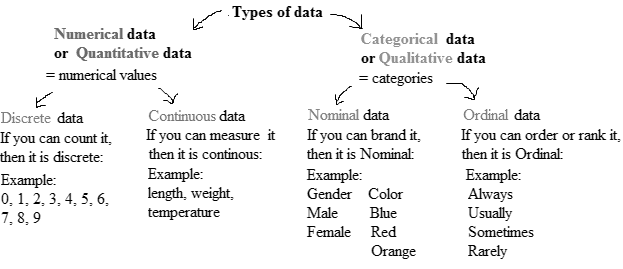
The variable which classifies individuals into categories is called qualitative variable, and the variable whichprovide information aboutquantity or number of something is quantitative variable. The variable number of cars owned by one tells how many cars one had been capable of possessing.
Therefore, the response is quantitative in nature.
e.
To identify:Whether Brenda’s answer reflect more of something and does it reflect Brenda’s answer is twice as much as something.
Answer to Problem 49E
The response is quantitative, Brenda’s answer reflect that she have more cars than Jason.
Yes! Brenda’s answer reflect that she have twice as many cars as what Jason have.
Explanation of Solution
Given information: A survey is administered by a marketing firm. Two of the people surveyed are Brenda and Jason. Three of the questions are as follows:
i. Do you favor the construction of a new shopping mall?
(1) Strongly oppose (2) Somewhat oppose (3) Neutral (4) Somewhat favor (5) Strongly favor
ii. How many cars do you own?
iii. What is your marital status?
(1) Married (2) Single (3) Divorced (4) Domestically partnered (5) Other
On question (ii), Brenda answers 2 and Jason answers 1.
Concept Involved:
There are various methods of collecting information by sampling. Once the information has been collected, the collection is called a data set. Variables can be divided into two types: qualitative and quantitative. Qualitative variables are also called categorical variable, classify individuals into categories. Quantitative variables are numerical and tell how much of something there is.
Qualitative variables come in two types: ordinal variables and nominal variables.
Ordinal variables are qualitative variables whose categories have a natural ordering.
Nominal variables are qualitative variables whose categories have no natural ordering.
Quantitative variables can be either discrete or continuous.
Discrete variables are those whose possible values can be listed. Often, discrete variables result from counting something, so the possible values of the variable are 0, 1, 2 and so forth.
Continuous variables can, in principle, take on any value within some interval.
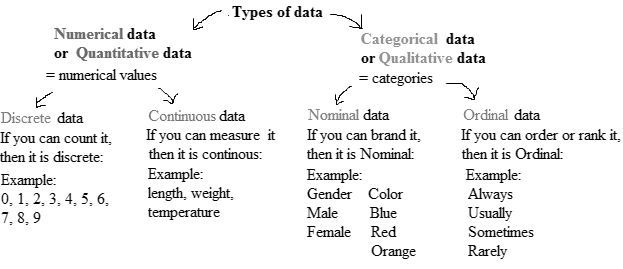
It is given that Brenda answered 2 and Jason answered 1 in response to given question, which clearly implies Brenda owns more cars than Jason. Brenda’s answer reflects twice as much as cars than Jason.
f.
To identify:Whether the responses to question (iii) nominal or ordinal.
Answer to Problem 49E
The responses to question (iii): nominal.
Explanation of Solution
Given information: A survey is administered by a marketing firm. Two of the people surveyed are Brenda and Jason. Three of the questions are as follows:
i. Do you favor the construction of a new shopping mall?
(1) Strongly oppose (2) Somewhat oppose (3) Neutral (4) Somewhat favor (5) Strongly favor
ii. How many cars do you own?
iii. What is your marital status?
(1) Married (2) Single (3) Divorced (4) Domestically partnered (5) Other
Concept Involved:
There are various methods of collecting information by sampling. Once the information has been collected, the collection is called a data set. Variables can be divided into two types: qualitative and quantitative. Qualitative variables are also called categorical variable, classify individuals into categories. Quantitative variables are numerical and tell how much of something there is.
Qualitative variables come in two types: ordinal variables and nominal variables.
Ordinal variables are qualitative variables whose categories have a natural ordering.
Nominal variables are qualitative variables whose categories have no natural ordering.
Quantitative variables can be either discrete or continuous.
Discrete variables are those whose possible values can be listed. Often, discrete variables result from counting something, so the possible values of the variable are 0, 1, 2 and so forth.
Continuous variables can, in principle, take on any value within some interval.
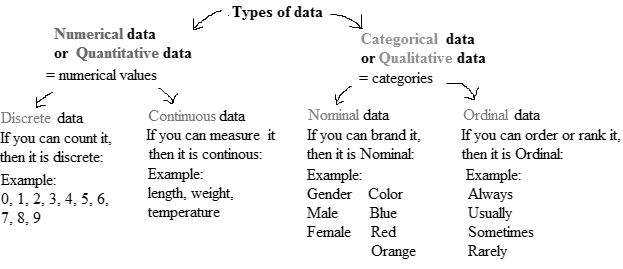
The values are classified into categories in a nominal variable, but no natural ordering is there in categories, whereas, the values are also classified into categories in an ordinary variable but a natural ordering is there in categories.
Thus, the responses to given question classifies one’s marital status into five categories.
Therefore, responses to given question are nominal.
g.
To identify:Whether Brenda’s answers reflect more of something and reflect twice as much as something.
Answer to Problem 49E
Brenda’s response of 4 and Jason’s response of 2 do not reflect more of something. Brenda’s answer does not reflect twice as much as Jason’s.
Explanation of Solution
Given information: A survey is administered by a marketing firm. Two of the people surveyed are Brenda and Jason. Three of the questions are as follows:
i. Do you favor the construction of a new shopping mall?
(1) Strongly oppose (2) Somewhat oppose (3) Neutral (4) Somewhat favor (5) Strongly favor
ii. How many cars do you own?
iii. What is your marital status?
- Married (2) Single (3) Divorced (4) Domestically partnered (5) Other On question (iii), Brenda answers (4) and Jason answers (2).
Concept Involved:
There are various methods of collecting information by sampling. Once the information has been collected, the collection is called a data set. Variables can be divided into two types: qualitative and quantitative. Qualitative variables are also called categorical variable, classify individuals into categories. Quantitative variables are numerical and tell how much of something there is.
Qualitative variables come in two types: ordinal variables and nominal variables.
Ordinal variables are qualitative variables whose categories have a natural ordering.
Nominal variables are qualitative variables whose categories have no natural ordering.
Quantitative variables can be either discrete or continuous.
Discrete variables are those whose possible values can be listed. Often, discrete variables result from counting something, so the possible values of the variable are 0, 1, 2 and so forth.
Continuous variables can, in principle, take on any value within some interval.
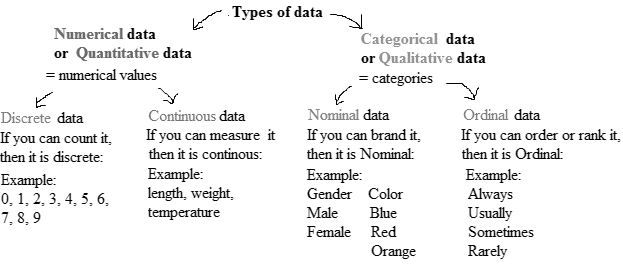
The values are classified into categories in a nominal variable, but no natural ordering is there in categories, whereas, the values are also classified into categories in an ordinary variable but a natural ordering is there in categories.
Thus, the responses to given question classifies one’s marital status into five categories.
Response to Marital status are nominal in nature, thus primarily the variable marital status is categorical. Hence, Brenda’s response of 4 and Jason’s response of 2 do not reflect more of something.
Therefore, Brenda’s answer does not reflect twice as much as Jason’s
Want to see more full solutions like this?
Chapter 1 Solutions
Elementary Statistics ( 3rd International Edition ) Isbn:9781260092561
- In a crossover trial comparing a new drug to a standard, π denotes the probabilitythat the new one is judged better. It is desired to estimate π and test H0 : π = 0.5against H1 : π = 0.5. In 20 independent observations, the new drug is better eachtime.(a) Find and plot the likelihood function. Give the ML estimate of π (Hint: youmay use the plot function in R)arrow_forwardCan you explain what this analysis means in layman's terms? - We calculated that a target sample size of 3626, which was based on anticipated baseline 90-day mortality of 22% and a noninferiority margin of no more than 4 percentage points, would give the trial 80% power, at a one-sided alpha level of 2.5%, accounting for a maximum of 5% loss to follow-up and for early stopping rules for three interim analyses.-arrow_forwardCan you help me understand this analysis? A 95.7% confidence interval is shown for the intention-to-treat analysis (accounting for alpha spending in interim analyses), and 95% confidence intervals are shown for the other two analyses. The widths of the confidence intervals have not been adjusted for multiplicity. The dashed line indicates the noninferiority margin of 4 percentage points.arrow_forward
- Title: Analyzing Customer Satisfaction for UnileverAs a member of Unilever's Customer Experience Management team, you are responsible forevaluating customer satisfaction levels and monitoring competitive moves. This case studyinvolves analyzing satisfaction data to test two key hypotheses about Unilever's performancerelative to its main competitor, Procter & Gamble (P&G).Unilever’s leadership team has emphasized the importance of customer satisfaction inmaintaining competitive advantage and market leadership. As part of this initiative, yourteam regularly monitors satisfaction scores and benchmarks them against competitors likeP&G.You are tasked with analyzing the provided dataset to answer the following questions:1. Does Unilever’s average customer satisfaction score meet the minimum threshold of2. 75%?Is there no significant difference between Unilever’s overall average satisfaction scoreand P&G’s average satisfaction score?arrow_forwardNeed help answering wuestionarrow_forwardThe following table shows a data set containing information for 25 of the shadow stocks tracked by the American Association of Individual Investors (aaii.com, February 2002). Shadow stocks are common stocks of smaller companies that are not closely followed by Wall Street analysts. Click on the datafile logo to reference the data. DATA file Company DeWolfe Companies Exchange Ticker Symbol Market Cap ($ millions) Price/ Gross Profit Earnings Ratio Margin (%) AMEX DWL 36.4 8.4 36.7 North Coast Energy OTC NCEB 52.5 6.2 59.3 Hansen Natural Corp. OTC HANS 41.1 14.6 44.8 MarineMax, Inc. NYSE HZO 111.5 7.2 23.8 Nanometrics Incorporated OTC NANO 228.6 38.0 53.3 TeamStaff, Inc. OTC TSTF 92.1 33.5 4.1 Environmental Tectonics AMEX ETC 51.1 35.8 35.9 Measurement Specialties AMEX MSS 101.8 26.8 37.6 SEMCO Energy, Inc. NYSE SEN 193.4 18.7 23.6 Party City Corporation OTC PCTY 97.2 15.9 36.4 Embrex, Inc. OTC EMBX 136.5 18.9 59.5 Tech/Ops Sevcon, Inc. AMEX ΤΟ 23.2 20.7 35.7 ARCADIS NV OTC ARCAF 173.4…arrow_forward
- The following table shows a data set containing information for 25 of the shadow stocks tracked by the American Association of Individual Investors (aaii.com, February 2002). Shadow stocks are common stocks of smaller companies that are not closely followed by Wall Street analysts. Click on the datafile logo to reference the data. DATA file Company DeWolfe Companies Exchange AMEX Ticker Symbol Market Cap Price/ Gross Profit Earnings Margin ($ millions) Ratio (%) DWL 36.4 8.4 36.7 North Coast Energy OTC NCEB 52.5 6.2 59.3 Hansen Natural Corp. OTC HANS 41.1 14.6 44.8 MarineMax, Inc. NYSE HZO 111.5 7.2 23.8 Nanometrics Incorporated OTC NANO 228.6 38.0 53.3 TeamStaff, Inc. OTC TSTF 92.1 33.5 4.1 Environmental Tectonics AMEX ETC 51.1 35.8 35.9 Measurement Specialties AMEX MSS 101.8 26.8 37.6 SEMCO Energy, Inc. NYSE SEN 193.4 18.7 23.6 Party City Corporation OTC PCTY 97.2 15.9 36.4 Embrex, Inc. OTC EMBX 136.5 18.9 59.5 Tech/Ops Sevcon, Inc. AMEX ΤΟ 23.2 20.7 35.7 ARCADIS NV OTC ARCAF 173.4…arrow_forwardThe following data show the year to date percent change (YTD % Change) for 30 stock-market indexes from around the word (The Wall Street Journal, August 26, 2013). a. What index has the largest positive YTD % Change? Round your answer to once decimal place. index with a YTD % Change of % b. Using a class width of 5 beginning with -20 and going to 40, develop a frequency distribution for the data. YTD % Change Frequency -20 - -15 -15 - -10 -10 - -5 -5 - 0 0 - 5 5 - 10 10 - 15 15 - 20 20 - 25 30 - 35 c. 1. 2. 3. 4.arrow_forwardThe following data show the year to date percent change (YTD % Change) for 30 stock-market indexes from around the word (The Wall Street Journal, August 26, 2013). Click on the datafile logo to reference the data. DATA file Country Australia Index S&P/ASX200 YTD % Change 10.2 Belgium Bel-20 12.6 Brazil São Paulo Bovespa -14.4 Canada S&P/TSX Comp 2.6 Chile Santiago IPSA -16.3 China Shanghai Composite -9.3 Eurozone EURO Stoxx 10.0 France CAC 40 11.8 Germany DAX 10.6 Hong Kong Hang Seng -3.5 India S&P BSE Sensex -4.7 Israel Tel Aviv 1.3 Italy FTSE MIB 6.6 Japan Nikkei 31.4 Mexico IPC All-Share -6.4 Netherlands AEX 9.3 Singapore Straits Times -2.5 South Korea Kospi -6.4 Spain IBEX 35 6.4 Sweden Switzerland SX All Share 13.8 Swiss Market 17.4 Taiwan Weighted 2.3 U.K. FTSE 100 10.1 U.S. S&P 500 16.6 U.S. DJIA 14.5 U.S. Dow Jones Utility 6.6 U.S. Nasdaq 100 17.4 U.S. Nasdaq Composite 21.1 World DJ Global ex U.S. 4.2 World DJ Global Index 9.9 a. What index has the largest positive YTD %…arrow_forward
- Describe a three step process you choose to determine how many elementary schools there are in the city of 5 million people.arrow_forwardQuiz: Exam 1 (Ch 1-4) z Scores Table-3.pdf x + edu/courses/308627/quizzes/2442507/take/questions/48957332 Canvas Hall It browser 5 Connect Set as default incorrect. • This exam is NOT resumable. Meaning, once you start the exam, you must complete it in its entirety. Any blank questions will be marked as By taking this exam, you agree to adhere to the academic integrity standards, which consist of NOT cheating in any way. To get the highest possible score, you are encouraged to review your notes before taking the exam. You may use your notes during the exam, but note that you should be familiar with the concepts and formulas before taking exam. z Scores Table.pdf Question 3 3 pts Here is a data from a survey asking young children how many hours they spend playing video games. The researchers reported the percent of boys and girls who played no games, less than 1 hour per day, 1-3 hours per day, or greater than 3 hours per day. The most common number of hours per day that boys played is…arrow_forwardWrite a Regression summary explaining significance of mode, explaining regression coefficients, significance of the independent variables, R and R square. Premiums earned Net income Dividends Underwriting Gain/ Loss 30.2 1.6 0.6 0.1 47.2 0.6 0.7 -3.6 92.8 8.4 1.8 -1.5 95.4 7.6 2 -4 100.4 6.3 2.2 -8.1 104.9 6.3 2.4 -10.8 113.2 2.2 2.3 -18.2 130.3 3.0 2.4 -21.4 161.9 13.5 2.3 -12.8 182.5 14.9 2.9 -5.9 193.3 11.7 2.9 -7.6arrow_forward
 Big Ideas Math A Bridge To Success Algebra 1: Stu...AlgebraISBN:9781680331141Author:HOUGHTON MIFFLIN HARCOURTPublisher:Houghton Mifflin Harcourt
Big Ideas Math A Bridge To Success Algebra 1: Stu...AlgebraISBN:9781680331141Author:HOUGHTON MIFFLIN HARCOURTPublisher:Houghton Mifflin Harcourt Holt Mcdougal Larson Pre-algebra: Student Edition...AlgebraISBN:9780547587776Author:HOLT MCDOUGALPublisher:HOLT MCDOUGAL
Holt Mcdougal Larson Pre-algebra: Student Edition...AlgebraISBN:9780547587776Author:HOLT MCDOUGALPublisher:HOLT MCDOUGAL Glencoe Algebra 1, Student Edition, 9780079039897...AlgebraISBN:9780079039897Author:CarterPublisher:McGraw Hill
Glencoe Algebra 1, Student Edition, 9780079039897...AlgebraISBN:9780079039897Author:CarterPublisher:McGraw Hill Functions and Change: A Modeling Approach to Coll...AlgebraISBN:9781337111348Author:Bruce Crauder, Benny Evans, Alan NoellPublisher:Cengage Learning
Functions and Change: A Modeling Approach to Coll...AlgebraISBN:9781337111348Author:Bruce Crauder, Benny Evans, Alan NoellPublisher:Cengage Learning Algebra and Trigonometry (MindTap Course List)AlgebraISBN:9781305071742Author:James Stewart, Lothar Redlin, Saleem WatsonPublisher:Cengage Learning
Algebra and Trigonometry (MindTap Course List)AlgebraISBN:9781305071742Author:James Stewart, Lothar Redlin, Saleem WatsonPublisher:Cengage Learning Algebra: Structure And Method, Book 1AlgebraISBN:9780395977224Author:Richard G. Brown, Mary P. Dolciani, Robert H. Sorgenfrey, William L. ColePublisher:McDougal Littell
Algebra: Structure And Method, Book 1AlgebraISBN:9780395977224Author:Richard G. Brown, Mary P. Dolciani, Robert H. Sorgenfrey, William L. ColePublisher:McDougal Littell





